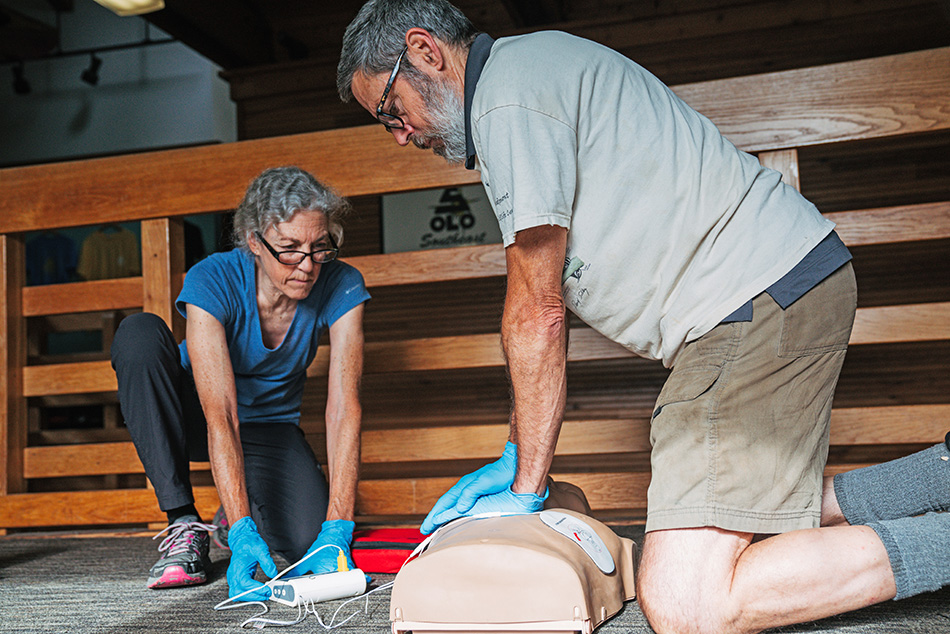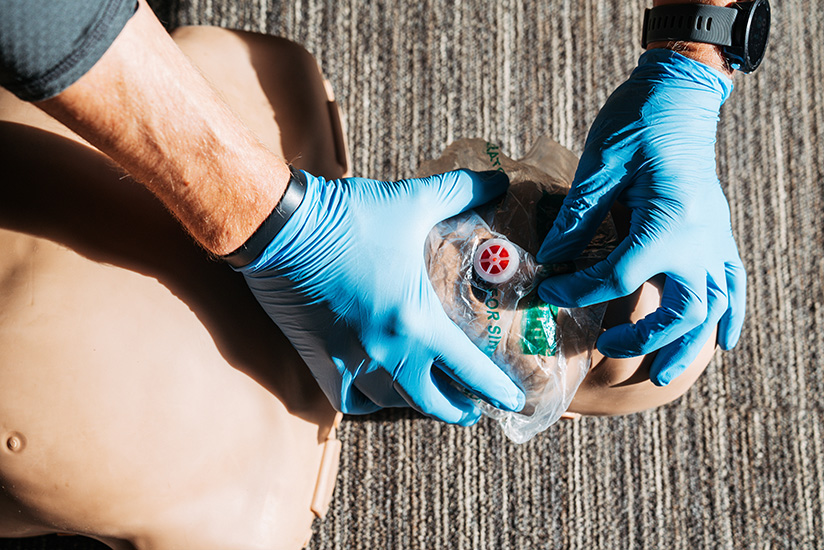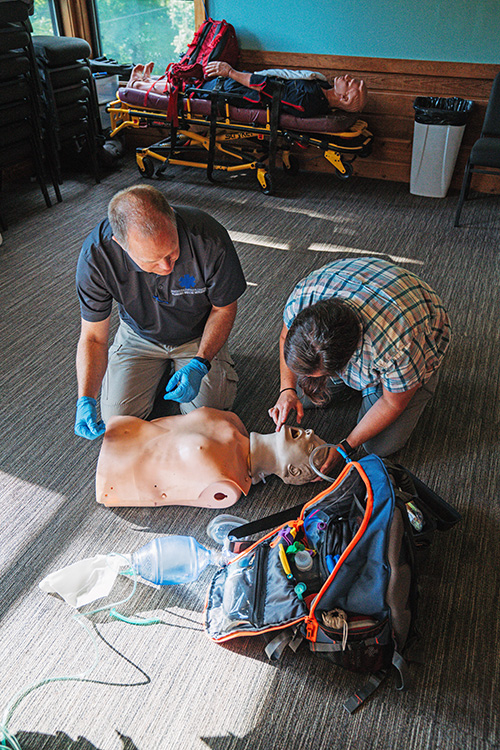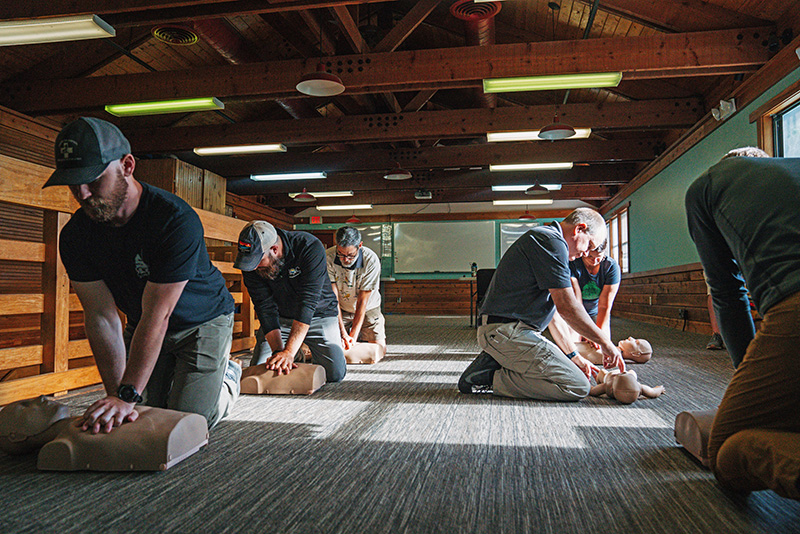Using an AED: Lifesaving Skills You Should Know

While many of us are at least familiar with the term “CPR” and have received training on how to perform it, the term “AED” may be less familiar. However, AEDs are a vital part of CPR and knowledge of how an AED works and how to use it properly can make a difference in an emergency.
While this article is not a substitute for training and certification in proper AED use, we wanted to get some more information. To do that, we headed over to SOLO Southeast, the NOC’s wilderness medicine program. SOLO Instructor and paramedic, Todd Doster sat down with us to answer some basic questions about AEDs, their use, their importance, and how to get trained.
When someone uses the abbreviation of AED, what does that mean?
“AEDs are devices that can analyze a patient’s heart and deliver a shock to restore a healthy heartbeat. AED is an abbreviation for Automated External Defibrillator.”

Why is defibrillation important?
“During cardiac arrest, a patient’s heart may be in a rhythm called ventricular fibrillation or ventricular tachycardia. These two rhythms do not allow for a coordinated contraction of our heart and thus do not circulate blood. This means that there is no pulse, and no heartbeat despite the electrical activity that is occurring. Defibrillation can get the heart out of those rhythms and into a healthy one.”
How does an AED restore the heart’s normal rhythm?
“The AED delivers a countershock via two adhesive electrodes placed on the chest. This electrical current travels through the chest wall and through the heart.
This in essence, “resets” the heart’s electrical system and gives the normal pacemaker sites within the heart itself a chance to restore order to the electrical activity in the heart.”
Can you use an AED on a pregnant woman?
“You can safely use an AED and perform CPR on pregnant patients.”

The AED is most advantageous to the EMT because…?
“AEDs are a powerful tool in the hands of EMT’s and other First Responders. These individuals are typically the first trained rescuers to arrive at the scene of a cardiac arrest, usually within a few minutes from the initial call to 9-1-1. The AED is a powerful supplement to CPR. Compressions alone may be effective, but the AED’s ability to reset/resynchronize the heart activity is incredibly valuable.”
When a person dies, they have 7 minutes…
“Our Brain’s cells begin to die within 4-6 minutes without oxygen. Our chances of being successfully revived from cardiac arrest then decrease by 10% every minute without care such as CPR and an AED.
According to the American Heart Association, over 70% of out-of-hospital cardiac arrests happen in homes and only about 40% of these victims receive the immediate help they need before professional rescuers arrive.”
If you could be so kind, please detail the differences between AED vs CPR? What should I do if someone is not responsive and not breathing?
“In the event a person collapses or is found unresponsive and after determining the victim is not breathing and not moving, immediately call 9-1-1 and then push hard and fast on the center of the chest at a rate of 100-120 compressions per minute.
This is called “hands-only” or “compressions-only” CPR and has been shown to be as effective in the first few minutes as conventional CPR.
This life sustaining process helps keep oxygen to the tissues until an AED can be placed and potentially deliver a shock to the patient to help restore normal circulation.”
The difference between CPR and AED are that CPR (cardiopulmonary resuscitation) is the process of chest compressions, rescue breaths, and application of an AED that is used to restore circulation in a person whose heart has stopped beating. The AED is one of the tools that we use to achieve that goal. You can perform CPR without an AED and even without rescue breaths (this is called “compressions-only” CPR) but it is most effective when we have an AED.
Why is having AED certification so important?
“AEDs are safe and easy to use, however nothing can take the place of quality training on how to safely and effectively respond to the aid of others.”
Studies have shown that survival rates dramatically increase if an AED is applied before EMS arrives. That AED is only effective if people use it properly.
All of our CPR courses include instruction in how to operate an AED. AEDs are designed to be simple to use but they’re not foolproof. If they’re not applied correctly (improper pad placement, not allowed to analyze fully, verbal cues ignored) though, they won’t work. A little bit of practice and coaching goes a long way toward getting people comfortable with how to use an AED in an emergency.

Understanding AED Certification
- AED certification is a crucial step in becoming proficient in operating these life-saving devices. It equips individuals with the skills and knowledge needed to respond effectively to sudden cardiac arrests. Before diving into the specifics, let’s clarify some key terms and concepts:
- AED Meaning: AED stands for Automated External Defibrillator. It’s a portable device used to restore a normal heart rhythm in cases of sudden cardiac arrest.
- Defibrillator: A defibrillator is a medical device that delivers an electric shock to the heart to treat life-threatening arrhythmias (irregular heart rhythms).
- External Defibrillation: This refers to the process of applying a defibrillator externally to a person’s chest to deliver a shock.
- CPR Machine: CPR machines or ‘mechanical compression devices’ are devices that deliver chest compressions instead of the rescuer using their hands. These are not the same as an AED and are only used by EMS or other rescue services. Some examples are the LUCAS and the AutoPulse.
The Basics of AED Training
Now, let’s address some key questions related to AED certification:
Where should AED pads be placed?
There are a couple of different pad placement sites. For adult patients, most AEDs should have one pad placed on the upper right portion of the chest and the other placed on the lower left side of the chest (anterolateral placement). Most AEDs switch to “anterior-posterior” (or anteroposterior) for children and infants. This means placing one pad on the center of the chest and the other on the center of the back. A straight line from one pad to the other should go directly through the patient’s heart.
Pads have to go onto bare skin. We can do compressions without removing a shirt or light jacket, but the AED pads cannot be placed over clothing.
When should the rescuer operating the AED clear the victim?
Before delivering a shock, it’s essential to ensure that no one is touching the victim. This includes both the rescuers and bystanders. The AED will provide clear instructions on when to “stand clear” before administering a shock.
How do you use an AED?
Using an AED involves a few key steps:
- Power on the AED.
- Attach the electrode pads to the victim’s chest as directed.
- Let the AED analyze the heart rhythm.
- Follow the AED’s prompts, which may include delivering a shock if necessary.
- Continue to follow the AED’s instructions until professional help arrives.
What is recommended to minimize interruptions in compressions when using an AED?
To minimize interruptions in chest compressions, it’s essential to coordinate actions effectively. Assign one person to perform chest compressions while another operates the AED. This ensures that chest compressions continue uninterrupted during AED setup and analysis.

An AED indicates that “no shock is advised.” What is most appropriate to do next?
If the AED advises “no shock,” resume CPR immediately. Continue chest compressions at a rate of 100-120 compressions per minute until professional medical help arrives.
Do not remove the AED. The AED will tell you to stop every 2 minutes so that it can analyze the patient. Listen to the prompts and follow the directions it gives. The AED may tell you to deliver a shock after a subsequent analysis.
What are some special considerations when using an AED?
When using an AED, consider the following:
- Ensure the victim is lying on a dry surface.
- Remove excessive chest hair, sweat, or water to improve pad adherence.
- Be cautious when using an AED around flammable materials.
- Always follow the AEDs voice prompts and visual cues.
SOLO Southeast offers training and certification for first aid, CPR and AED use as well as first responder and EMT training.
We strongly encourage everyone to get certified in CPR and use of AEDs. If you are struggling to find a suitable program near you, please contact us and we will be happy to assist you.
